As a music producer, sequencer plugins have often been creative catalysts for my workflow that shape the way I craft my music, especially when I am out of ideas or feeling lazy about my beats. So here are the 11 best Sequencer VST Plugins to sketch out a new melody, try different rhythmic patterns, or generate dynamics using automation.
Music production today is quite competitive and technologically advanced, and as producers, we must take advantage of the technology to bring our ideas to life and just play around to discover something interesting. Sequencer plugins, for me, streamline the tedious aspects like arranging MIDI notes and timing, doing more elaborate modular synthesis, sound designing, etc.
Especially if you are in film music or scoring, you will find these quite helpful. Some of the greatest soundtracks, like The Social Network by Atticus Ross and Trent Reznor, showcase the power of sequenced patterns in creating unforgettable, emotionally resonant scores. With these plugins, you can achieve cinematic brilliance.
In fact, with advancements in AI-driven composition, generative music, and real-time parameter control, these plugins integrate features like adaptive sequencing, deep MIDI integration, and cross-platform compatibility that could open innovative creative doors for musicians.
I’ll walk you through some of my favorites, some of which I have been using for years and some that I just started using. I will highlight the best of these plugins so at least one of these plugins excites you to add them to your workflow.
1. Stepic by Devicemeister (Step/MIDI/Polyphonic/Polymetric)
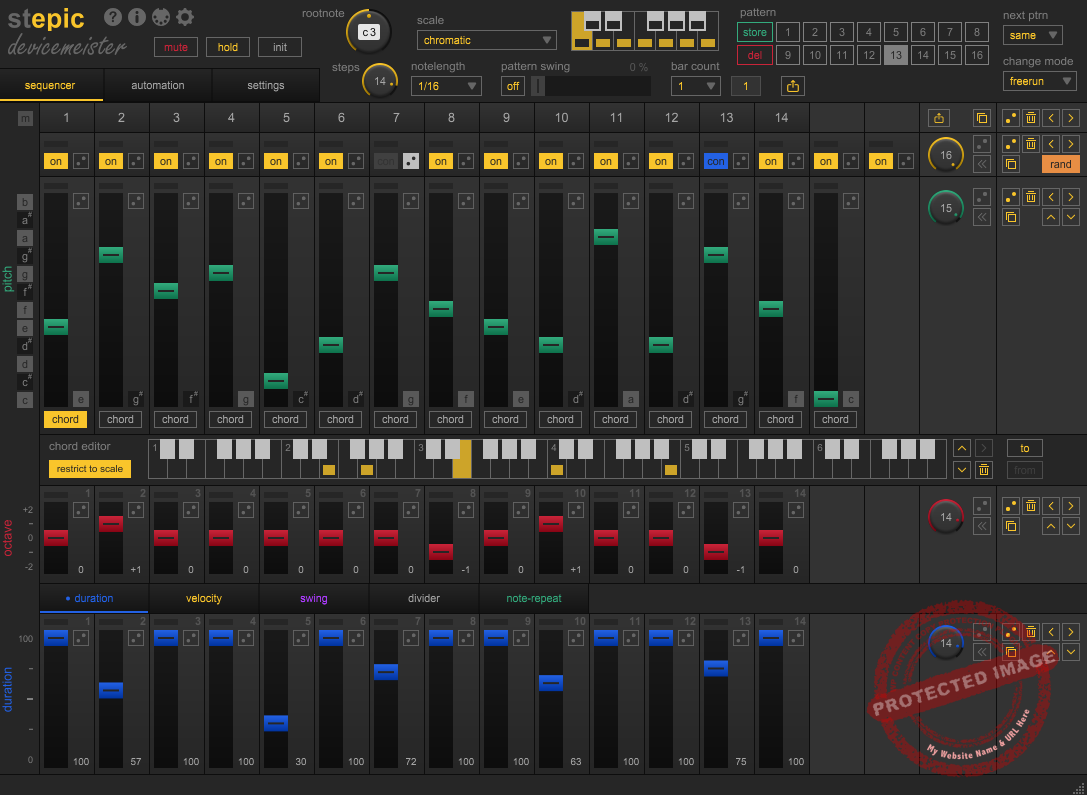
Stepic is a no-BS-sequencer that works on Pattern System, which allows you to save up to 16 patterns.
You can sequence them together using pattern concatenation, enabling compositions that extend well beyond the typical 16 steps. If you’re tired of loops that feel repetitive, Stepic’s Individual Sequence Lengths for pitch, octave, duration, etc., can create evolving sequences.
- Intuitive Tabs
Stepic’s workflow is thoughtfully designed and consists of three intuitive tabs: Sequencer, Automation, and Settings. The Sequencer tab serves as your primary workspace, offering independent sequencing lanes for Pitch, Octave, and Duration.
You can assign notes to steps, lock them to predefined or custom scales, and introduce octave shifts for added depth. Additionally, you can adjust note lengths to create sharp staccatos or long, sustained tones. Each step includes a Chord Button, which you can use to assign unique chords to individual steps for harmonic layering.
- 8 Modulation Sequencer
The Automation tab offers 8 modulation sequencers that let you control parameters for synths, effects, and hardware. From automating filter sweeps to panning or resonance, you can use this tab to add dynamic movement and texture to your sound. Finally, the Settings tab ties everything together, handling MIDI routing, hardware integration, and randomization preferences.
- Scale System and Chord Play
What I love about this plugin are the root note and scale settings that keep your music grounded harmonically with its Scale System. You can lock notes to predefined scales or craft your own, ensuring that every sequence stays in key. Stepic’s Chord Play lets you assign unique chords to each step across six octaves, suitable for polyphonic compositions. This really helps you add better textures.
- Parameter Modulation Capabilities
Next, its Parameter Modulation capabilities, with eight modulation sequencers, allow you to control synth parameters, effects, or hardware devices, adding dynamic life to your tracks. For even more variation, its Probability and Randomization tools introduce controlled chaos, making every playback unique.
Lastly, I like how it makes my workflow convenient with its Drag & Drop MIDI Export, which allows you to transfer up to 16 bars of MIDI, including CC automation and randomization settings, directly into your DAW. The MIDI Device Manager organizes your hardware and plugins, putting every parameter within reach, while the Clipboard Function speeds up pattern editing with quick copying and pasting.
Stepic by Devicemeister is compatible with DAWs that support AU and VST3 plugins and is available for Windows and Mac operating systems. It’s also available as Max for Live.
2. Splice Beatmaker (Drum)
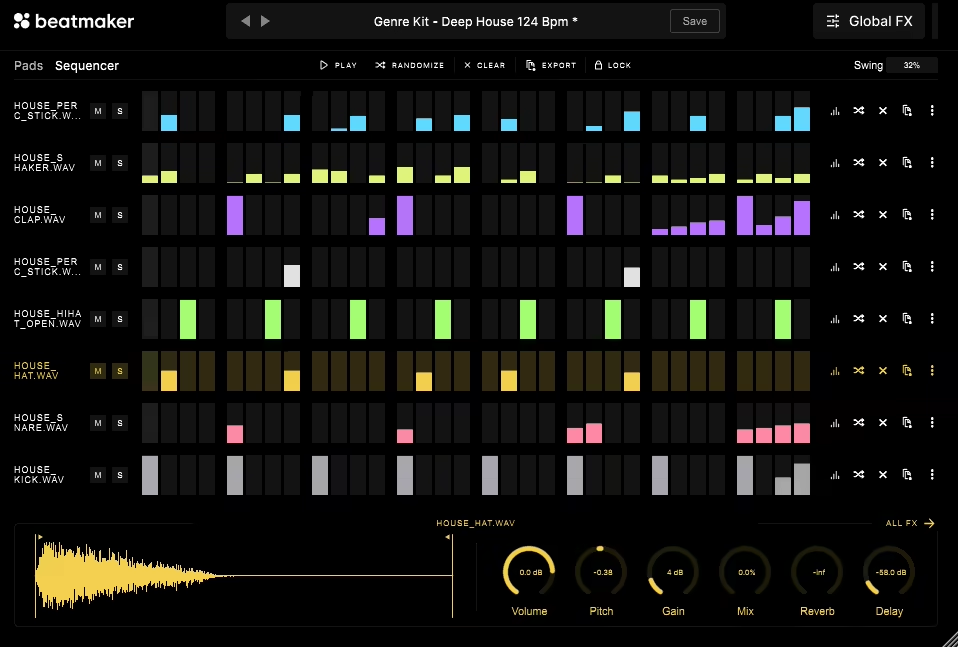
If you are after a free yet powerful drum sequencer, check out Beatmaker.
Splice Beatmaker is a free (with Spice Creators Plans) and lightweight drum sequencer with a simple workflow, which I will get right away. At its heart, it’s built around two main views: Pads and Sequencer. The ‘Pads’ view presents a sleek 4×2 grid, allowing you to load up to eight drum sounds simultaneously.
- Rich Presets and Customizable Controls
You can either drag and drop samples straight from Splice Sounds (which makes it so easy to experiment) or use one of the built-in presets if you’re looking to get started quickly. From there, it’s all about tweaking. Each pad has customizable controls like volume, pitch, and gain, and you can even add effects like reverb and delay to shape the sound.
- ALL FX Section
If you’re like me and love getting into the details, the ALL FX section might be the right fit for you, as it lets you push your sound further with tools like distortion, flanging, and multi-mode filters.
- Sequencer View
You can also switch over to the Sequencer view, where you get a 32-step grid to map out your beats. I find this section very intuitive because you can add notes by clicking, adjust their volumes, or play around with the built-in groove presets.
- Randomize Button
There’s also a RANDOMIZE button, which I use a lot when I feel stuck creatively. And if you don’t like where things are going, the CLEAR option makes it easy to start over without a fuss. Once I’ve got a groove I’m happy with, I can quickly export it as MIDI or audio and bring it into my DAW for further tweaking.
If you’re a Splice subscriber, you’d likely appreciate Beatmaker’s integration with Splice’s sound library. The Drag & Drop MIDI Export feature is also a time-saver, and having access to so many fresh sounds makes it easy to keep the creative flow going.
Splice Beatmaker by Devicemeister is compatible with DAWs that support AU and VST2/3 plugins and is available for Windows and Mac operating systems.
3. HY-Plugins HY-MPS3 (Step/Block/MIDI)
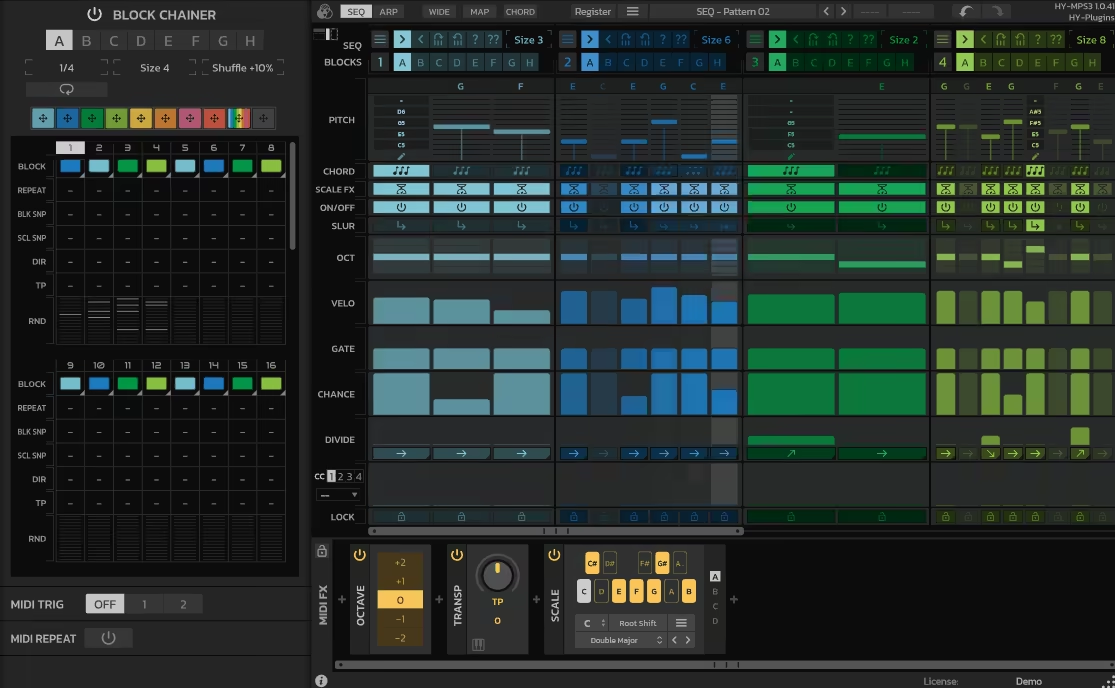
The HY-MPS3 is literally one of the best sequencer plugins out there with its ‘block-based modular’ workflow.
HY-MPS3 is a little complicated and may get overwhelming, but I will tell you what that means right away. Stay patient with me, and I assure you it’ll feel rewarding once you get hold of this.
- Up to 16 Blocks
Think of it like building a sequence out of building blocks. Each block can hold its own pattern, scale, and playback behavior. You can chain up to 16 blocks together, creating a dynamic, evolving sequence that can stretch across multiple measures.
- 8 Snapshots per Block
Each block itself is incredibly versatile. You have up to 8 snapshots per block, letting you switch between different variations of a pattern within a single block. For example, you could program a basic rhythm on Snapshot A and then add accents or variations in Snapshots B and C, giving you instant options for live performance or composition tweaks.
- Multiple Playback Modes
HY-MPS3 offers multiple playback modes for each block. You can run patterns forward, backward, randomly, or even in more unique modes like leapfrog (1-3-2-4) for extra variety. You can also override playback directions for specific blocks, ensuring you maintain creative control over how your sequence flows.
- Block Chaining System
The block chaining system lets you go deeper and allows up to 16 chained patterns. Imagine each block containing a mix of steps, playback directions, and scales. You can even assign probabilities to how often each block plays, adding a layer of randomness to your song structure.
What I find really exciting is the fine-grained control one gets over every step.
- Pitch and Octaves: You can quickly assign notes and pitch shifts to steps, locking them into scales so everything stays harmonically coherent.
- Velocity and Gate: Craft expressive dynamics by tweaking the velocity of individual steps or extending note lengths for legato phrasing.
- Ratcheting: Add quick, repeating bursts within a single step for rhythmic flair, a lifesaver when working on percussive elements or arpeggios.
I’d also like to mention the intriguing scale-snap feature, which is another gem that lets you assign up to five scales to a sequence and switch between them, creating dynamic key changes without reprogramming your patterns.
- Selective Randomization Feature
Next, I believe sometimes, music needs a little chaos, at least for me. For that, you get to assign randomization to parameters like pitch, gate, and velocity, giving your sequences a fresh, unpredictable edge. The probability controls let you fine-tune how often a note will trigger, perfect for creating evolving textures or generative music. You have to use this part to realize how much impact this feature has on the workflow.
What’s cool is how randomization can be applied selectively, and you can lock certain steps to preserve core elements while letting others evolve dynamically. The plugin is very adaptable during live sessions, too.
However, HY-MPS3 is not for everyone. You have to be at least a little ‘modular-minded’ in order for you to not just use but thoroughly enjoy it. But I am telling you it’s worth the effort to learn this workflow. It may or may not be for you, but I really suggest trying this plugin.
If you’re looking for a sequencer that can handle everything from straightforward patterns to highly intricate, evolving sequences, HY-MPS3 can fulfill your needs.
HY-MPS3 is compatible with DAWs that support AU and VST/VST3 plugins and is available for Linux, Windows, and Mac operating systems.
4. ADSR Orbit (MIDI/Euclidean)
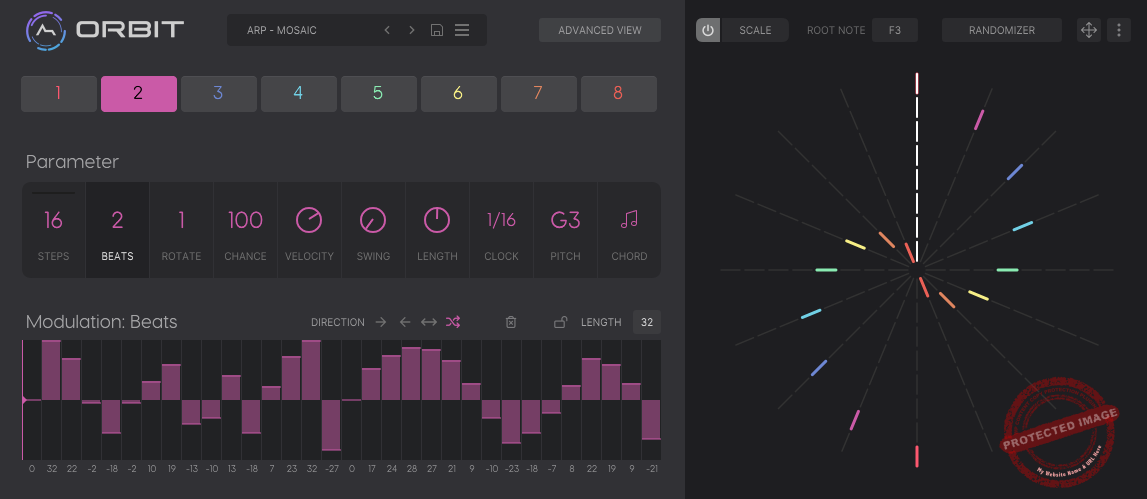
Orbit is a versatile Euclidean sequencer vst plugin for crafting melodies, chord progressions, drum patterns, and more.
If you’re not into nerdy information, feel free to skip the next two paragraphs, but if you are like me, you will find Orbit pretty great.
- Euclidean Algorithm
The Euclidean algorithm is an ancient mathematical method, to distribute events evenly across a sequence, resulting in captivating rhythms that feel both structured and unexpected. By evenly spacing notes or beats over a set number of steps, it creates intriguing, non-repetitive rhythms. This controlled randomness introduces subtle variations that make sequences feel organic and engaging.
- Shift Beats Off-grid
Imagine programming a 16-step sequence where you can effortlessly shift beats off-grid to add syncopation or complexity. It’s like having a musical assistant that adds an element of surprise to your compositions without losing cohesion.
- Adjust Attributes
Moreover, you can adjust attributes like note pitch, velocity, and step probability to shape each event precisely. For example:
-
- Pitch and Scale: Snap notes to a chosen key or scale to ensure harmonic consistency.
- Step Probability: Decide how often specific notes should play, adding a humanized feel to your tracks.
- Advanced Modulation: Use Orbit’s modulation features to automate shifts in pitch, dynamics, or even MIDI output, letting your sequences evolve over time.
- 80 Presets Across 7 Genres
Regarding presets, Orbit includes 80 presets across 7 genres, offering a quick starting point for your sessions. From there, you can tweak to your heart’s content, layering your ideas with Orbit’s extensive customization tools.
However, the best part about Orbit is its intuitive interface that transforms sequencing into a visual and interactive experience. At its core is the circular event wheel, a feature that provides clear visual feedback on how notes are distributed across a sequence. This makes it easy to see rhythm and timing at a glance.
- Step Rotation Tool
Then there’s the step rotation tool that allows you to shift patterns within the sequence, adding syncopation or an off-grid feel to your rhythms. If you’re working on polyphonic melodies or intricate drum patterns, Orbit can program up to four independent tracks, referred to as “bands,” each with its own unique parameters and MIDI routing.
This multi-band functionality ensures unparalleled flexibility, allowing you to route each band to different MIDI channels for highly customizable arrangements.
ADSR Orbit is compatible with DAWs that support AU and VST3 plugins and is available for Windows 10 (and newer) and Mac 10.14 (or later) operating systems.
5. 510k SEQUND (Euclidean)
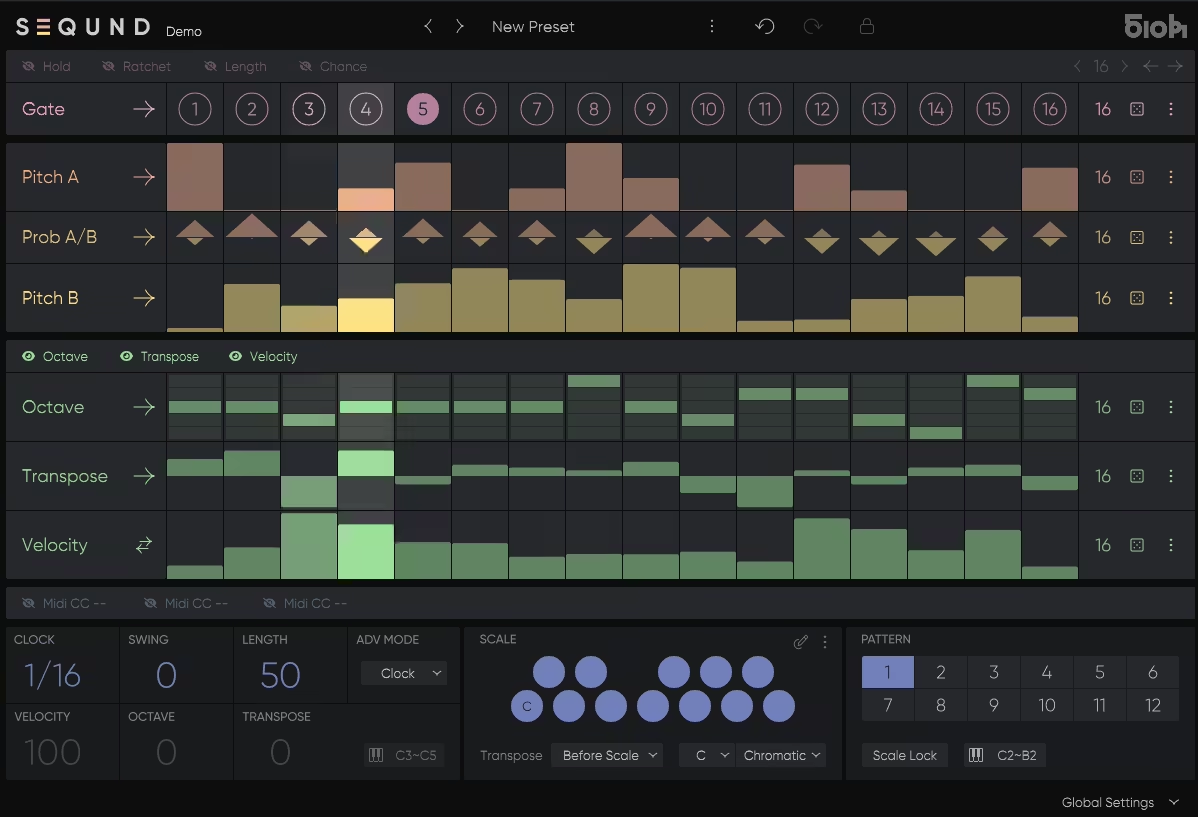
SEQUND is also an Euclidean plugin that redefines what’s possible in a 16-step sequencer with its polyrhythmic capabilities.
Each lane, whether it’s for gate, pitch, or MIDI CC, can have its own independent step length. This means you can easily create complex patterns where the rhythm and melody move independently, generating layers of subtle variation and groove.
- Intuitive Workflow
SEQUND‘s workflow is thoughtfully designed, wherein you Gate your sounds, choosing from 1 to 16 steps, to establish rhythmic patterns that form the foundation of your composition. Next, you can also craft the melodies using Pitch A or Pitch B individually or by blending the two with a probability feature that introduces dynamic variation into your sequences. You can alternate between two pitch lanes using a probability lane.
- Versatile with Many Controls
For further detail and refinement, you can adjust the Octave, Transpose, and Velocity bars, which allow for greater harmonic richness and expressive nuances. You also get the Clock, Swing, and Length controls that give you the tools to sculpt the groove of your sequence, ensuring it aligns perfectly with your desired feel.
- Scale Settings
Meanwhile, the Scale settings guarantee that every note remains in key. Some key controls that I find really important in this plugin are:
-
- Gate and Hold: Control note lengths and add glide for expressive basslines and leads.
- Transpose Before or After Scale Quantization: Keep your melodies in key while experimenting with harmonic shifts, all in real-time, using MIDI input.
- Assignable MIDI CC Lanes: Add dynamic control over synth parameters like cutoff or resonance, making your sequences come alive.
- 12 Patterns per Preset
Moreover, SEQUND’s intuitive interface comes with up to 12 patterns per preset, all instantly recallable via MIDI, which lets you dynamically switch between patterns or use the “punch-in” mode to create seamless transitions during live performances.
510k SEQUND is compatible with DAWs that support AU and VST3 plugins and is available for Windows 10 (and newer) and Mac 10.14 (or later) operating systems.
6. HY-Plugins HY-SEQ32
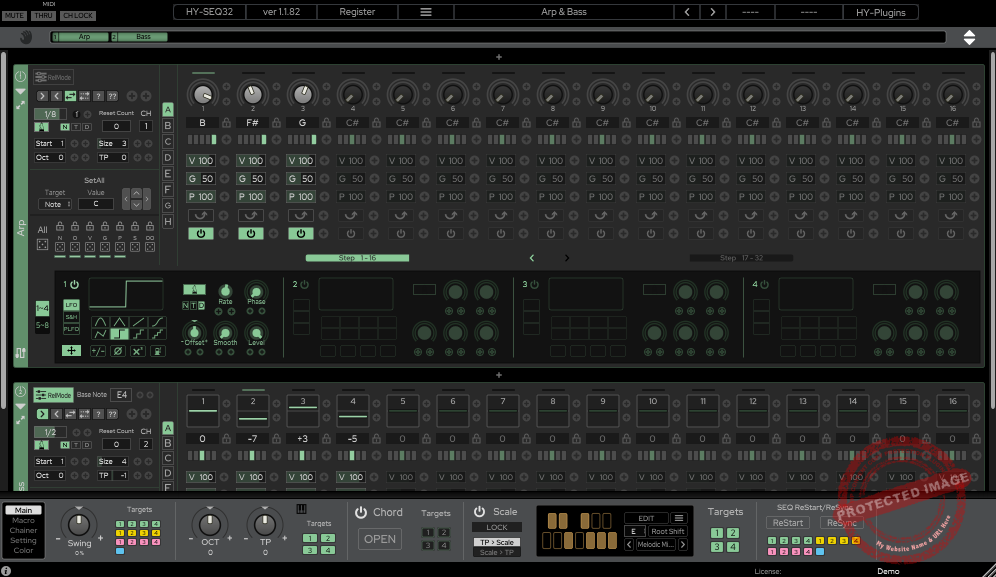
Need more control over your sequencer vst to create complex projects? HY-SEQ32 can solve your problem.
- 32-Step Sequencer
HY-SEQ32 is a powerful 32-step sequencer plugin that draws inspiration from classic analog sequencers, bringing a modern and versatile approach to step sequencing. When you open the plugin, the interface is blank, like an empty canvas. It lets you load different sequencers for Pitch, other parameters, CC, etc.
- 5 Distinct Units with 8 Dedicated Modulation Controls
In other words, you can create evolving patterns through extensive parameter modulations, and it offers a modular approach with 5 distinct units: pitch SEQ, parameter SEQ, CC SEQ, CC Rack, and Oct/Tp SEQ. Each unit is equipped with 8 dedicated modulation controls, enabling precise adjustments for intricate sequencing.
The pros and cons of this plugin are how straightforward and ‘professional’ it is. It’s not exactly designed from an aesthetic pov, but the utility it offers is undeniable. You can run up to 15 sequencer and rack units simultaneously, which is just awesome for building complex and layered patterns.
- 4 Pitch SEQ Units
For example, you can have up to 4 Pitch SEQ units generating MIDI note messages, four Param SEQ units controlling those Pitch SEQ parameters, four CC SEQ units for sending MIDI CC messages, one Oct/Tp SEQ to handle master octave and transpose, and two CC Rack units for even more MIDI CC flexibility.
- Chord FX and Scale FX
On top of that, the Chord FX lets you turn single MIDI notes into rich chords, and the Scale FX ensures everything stays musically on point by mapping notes to your chosen scale.
What I love is how the modulation is built into each unit. Every unit has its own set of modulators, so you can really fine-tune the behavior of that specific part of your sequence. It’s all about local control here and no cross-modulation between units. This keeps things clean and manageable.
For instance, if you’re working with a Param SEQ, you don’t have to worry about modulators from the Pitch SEQ interfering. It’s straightforward and intuitive, which makes creating complex sequences feel effortless.
- 5-track MIDI Recorder
And then there are all the extra features that make HY-SEQ32 such a joy to use. You’ve got drag-and-drop modulation assignments, 8 Macro knobs for broad adjustments, and a pattern sequencer that chains snapshots for smooth transitions. There’s even a 5-track MIDI recorder to capture your ideas on the fly.
Plus, the interface is resizable, so it always fits your setup perfectly. HY-SEQ32 really feels like a complete sequencing solution that adapts to your workflow and lets you push your creative boundaries.
HY-SEQ32 is compatible with Windows, Mac, and Linux operating systems in VST, AU, and AAX plugin formats.
7. Audiomodern Playbeat 3
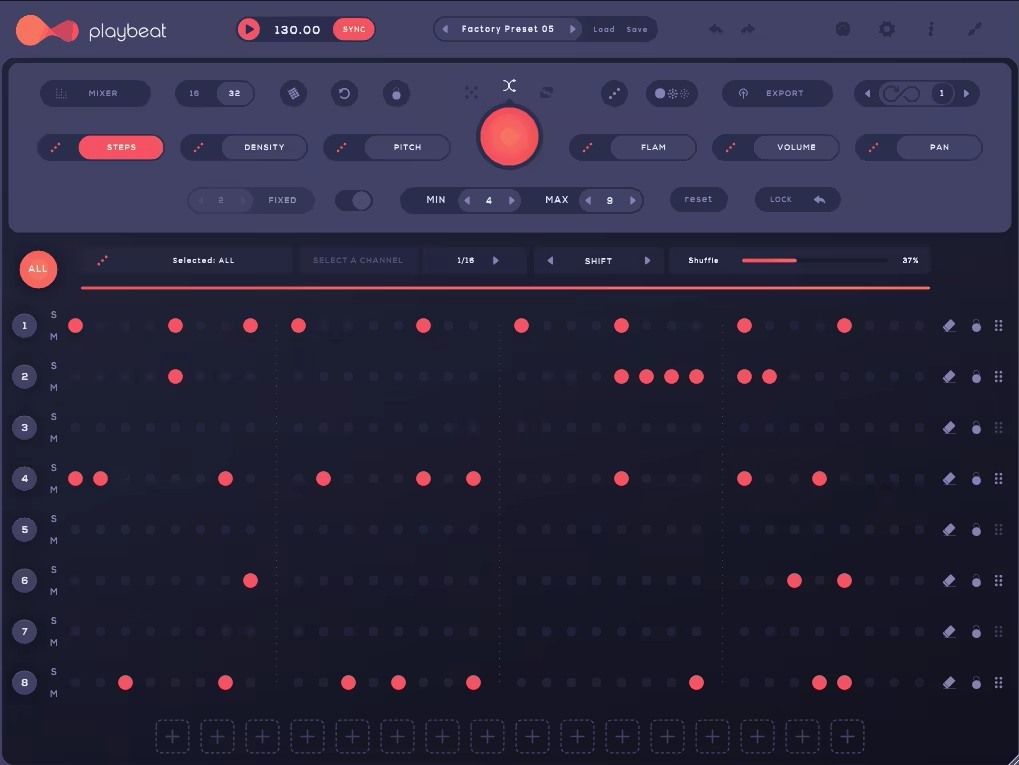
Playbeat 3 is a groove randomizer and one of the most creative sequencer plugins out there.
At the heart of Playbeat 3 (now version 4) is its step sequencer, where the magic happens. You have 8 channels, each capable of sequencing up to 32 steps. Loading samples is as simple as dragging them in from your DAW or selecting them from the built-in library.
- Randomize Specific Sections
For quick creativity, the plugin’s randomization controls let you shuffle parameters like steps, density, pitch, flam, volume, and pan. And if you want even more control, you can randomize specific sections or lock channels and steps to preserve parts of your groove while experimenting with others.
- Remix Feature
One of my favorite features is the “Remix” button, which subtly tweaks your pattern to create variations without starting over. For live performances, the “Latch” function lets you hold down the randomization button for momentary changes, perfect for adding fills or surprises to your rhythm.
- Detailed Step Sequencer
The step sequencer itself is incredibly detailed, you can adjust timing, shuffle, and even focus on specific ranges of steps. For added depth, the density control lets you split a step into rapid sub-steps, while the flam function introduces realistic, staggered hits.
- “Infinity” Mode
Next, I am quite happy with its “Infinity” mode, which automatically randomizes patterns every few bars, keeping your grooves fresh and dynamic. There’s also a “Disintegration” mode that gradually removes steps from your sequence over time, creating evolving rhythms that deconstruct organically.
- “Remix Pads” and “Sample Triggers”
Another aspect I love about Playbeat 3 is that it’s equally great for live performance and studio production. Its “Remix Pads” and “Sample Triggers” are perfect for triggering variations and samples in real-time, whether you’re using a MIDI controller or simply clicking on the pads. The intelligent algorithms behind the remix function can generate up to 16 variations of your groove, giving you plenty of creative options to explore.
Playbeat 3 is available for Windows and Mac operating systems and compatible with DAWs supporting VST, VST3, AU, AAX, and Standalone plugin formats.
8. Toneworks Catalyst (Creative/Step)
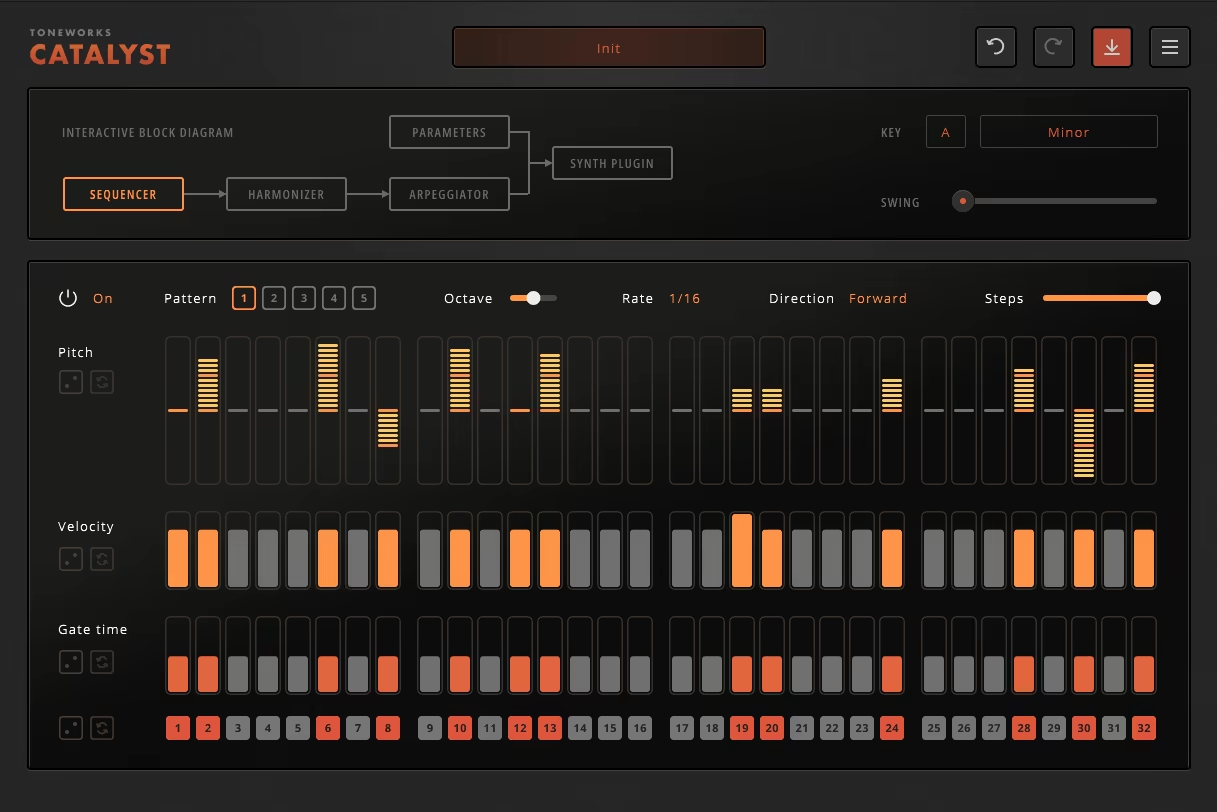
Catalyst is great for building basslines, melodies, chord progressions, and arpeggios.
- Step Sequencer, Harmonizer, and Arpeggiator
Catalyst is a MIDI sequencing tool, but it feels so much more creative than just programming notes. It blends a step sequencer, harmonizer, and arpeggiator into one intuitive system. Once I started using it, I realized how much time I’d save compared to my usual workflow in the piano roll.
- 32-step Monophonic Sequencer
The center of it is the 32-step monophonic sequencer, which I find incredibly easy to use. Each step lets you tweak pitch, velocity, and gate time, and it keeps everything locked to your chosen scale, so you don’t have to worry about hitting wrong notes.
- Automatic Sequenced Notes Adjustment
What’s really cool is that if you decide to change the scale or key later, the sequenced notes will adjust automatically. It’s been such a lifesaver when I’ve wanted to experiment with different harmonic ideas without starting from scratch. Plus, you can tie steps together to create longer notes or even glides if your synth is in legato mode, which is great for leads or basslines.
- Pattern Slots
One feature I keep coming back to is the pattern slots. You can save up to five variations, and switching between them is as simple as pressing a black key on your MIDI keyboard. The white keys let you transpose patterns on the fly, so it’s super fun for live jamming or coming up with different variations quickly.
- Powerful Harmonizer
The harmonizer is where Catalyst really shines for me. You feed it a single note, and it builds chords based on the selected scale. It’s so simple, but it opens up so many possibilities. You can add 6th, 7th, or 9th notes to the chords, tweak inversions, and even use the density slider to adjust how full the chords sound, from tight two-note intervals to big, lush pad-like stacks.
- Randomization Button
Honestly, I’m not a music theory expert, so I lean on the randomization button when I’m stuck, and it often spits out progressions that inspire me in ways I didn’t expect. Once I’ve got my chords set, I usually feed them into the arpeggiator. Unlike most arpeggiators that lock you into predefined patterns, Catalyst lets you create your own.
- Pitch, Velocity, and Gate Time Controls
Each step in the arpeggiator can be customized for pitch, velocity, and gate time, just like the sequencer. What I love is that it doesn’t just play the notes in the chord, it can also add extra notes above or below to create these sprawling, sweeping patterns. The ability to create rising or falling patterns and randomize them keeps things feeling fresh, and I’ve used it to come up with some pretty intricate melodies.
One of my favorite ways to use Catalyst is for quick jamming sessions. I’ll map a simple sequence, save a few patterns, and then switch between them or transpose them live. It’s also been a lot of fun experimenting with different scales, stepping out of the usual major or minor scales, and trying things like Dorian for house tracks or Phrygian for techno, which has led to some cool results.
Toneworks Catalyst is compatible with MacOS 10.12.6 (Sierra), 10.14.6 (Mojave), 10.13.6 (High Sierra), 12.6.3 (Monteray), 11.7.4 (Big Sur), 10.15.7 (Catalina), or 13.6 (Ventura) and Windows 10 or higher operating systems, and is available in VST, VST3 or AU formats.
9. Sugar Bytes Nest (MIDI/DIY/Modular)
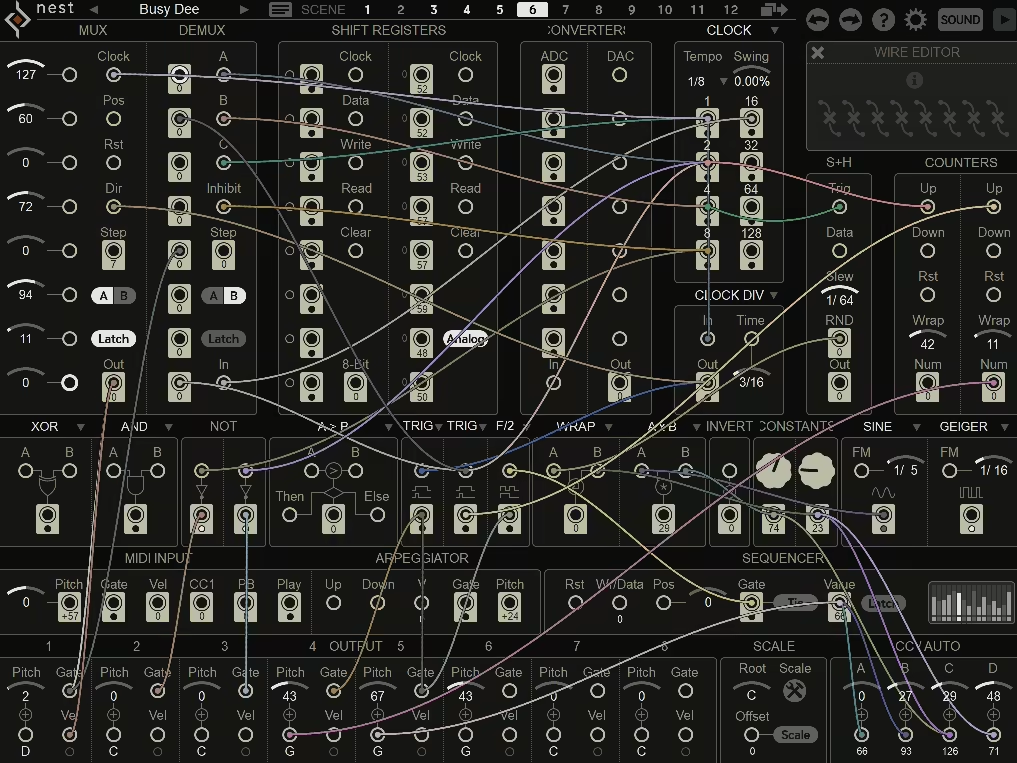
What makes Nest so exciting is that it combines the logic and flexibility of old-school circuit-based sequencing with the power and versatility of modern software.
- 20+ Modules
Sugar Bytes Nest is made up of 20+ modules inspired by everything from classic transistor-based circuits like shift registers to programming staples like if/else logic and math operations. You can wire these modules together to generate and process triggers, rhythms, and numbers, giving you an almost limitless canvas for creating custom sequencing environments.
- Voice Assignments
Whether you’re building a basic step sequencer or a complex, self-generating music system, Nest can handle it. One of the most powerful features is how Nest handles voice assignments. You have 8 MIDI voices to play with, and you can send them to up to 4 sound targets, whether that’s VST plugins, Nest’s built-in synths and drum machines, or external MIDI hardware.
For example, you could layer all 8 voices into a massive chord, split them across drums and melodies, or route them into your hardware setup for intricate patterns. It’s super flexible, and you can even set up 12 patch scenes to switch between variations of your sequence on the fly.
- Wire-patching System
What I love about Nest is how intuitive and creative the wire-patching system is. It’s like playing with Lego bricks for music, dragging modules into place and connecting them unlocks endless possibilities. You can turn numbers into beats and beats into patterns and distribute them across multiple sound sources.
The process feels alive and experimental, and the results are always surprising. It’s perfect for building everything from intelligent song machines to quirky generative grooves.
- Wire and Sound Pages
Nest’s two main pages, Wire and Sound, keep things clean and manageable. On the Wire page, you create patches using the 20+ modules, shaping rhythms, pitches, and modulation. The Sound page lets you route those signals into 4 channels, each of which can host internal synths, VST plugins, or MIDI outputs.
Sugar Bytes Nest is compatible with macOS 10.13 or higher and Windows 7 or higher operating systems and is available in VST2, VST3, AAX, and Standalone plugin formats.
10. HY-RPE2 (Euclidean)
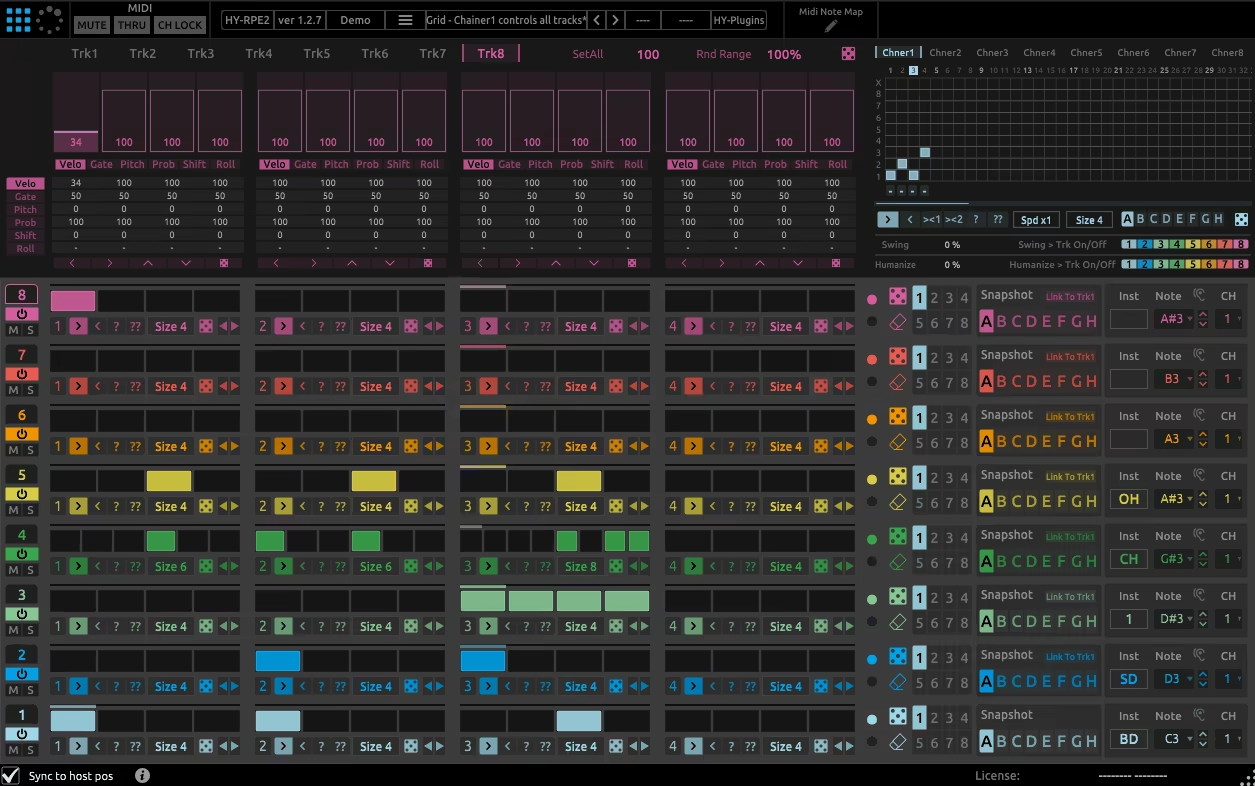
HY-RPE2 is an 8-track MIDI sequencer plugin packed with features designed to make both simple grooves and intricate sequences easy to create.
HY-RPE2 has two distinct sequencing engines, Grid and Euclidean. The Grid engine allows for a traditional step-sequencing workflow, where you manually assign notes and timing across tracks.
- Euclidean Engine
In contrast, the Euclidean engine uses mathematical algorithms to distribute notes evenly across steps, creating rhythmic yet unpredictable patterns, which is perfect for modern electronic or cinematic compositions.
- Drag-and-Drop Modulation Assignment
The drag-and-drop modulation assignment in the Euclidean mode is an intuitive way to add movement and variation to your sequences. You also have access to four LFO/Sample & Hold units and four macro knobs/buttons for additional modulation possibilities, allowing you to create evolving, dynamic sequences effortlessly.
- MIDI Recorder, MIDI Learn, and MIDI Note Map
For those who work extensively with hardware or want to refine their workflow, the plugin includes a MIDI Recorder, MIDI Learn, and MIDI Note Map features. These tools ensure seamless integration with your existing setup, whether you’re controlling hardware synths, triggering samples, or creating generative music within your DAW.
The interface of HY-RPE2 is clean and resizable, making it easy to adapt to different screen sizes and workflows. Each track offers dedicated settings for pitch, velocity, gate, and modulation, giving you granular control over every aspect of your sequence.
HY-RPE2 is compatible with DAWs that support AU and VST/VST3 plugins and is available for Linux, Windows, and Mac operating systems.
11. Audio Damage Replicant 3
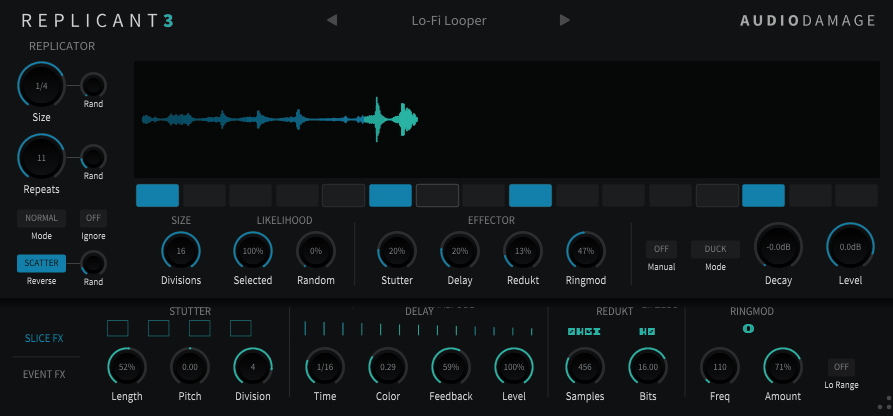
At its heart, Replicant 3 is a tempo-synced slicing, looping and sequencer vst plugin. It takes your audio, divides it into slices, and lets you repeat, modify, and layer those slices in unique and unpredictable ways.
Unlike traditional delay effects, which process the entire signal, Replicant 3 zeroes in on individual segments of your track, making it ideal for crafting glitchy, rhythmic textures and stutters that stand out.
- Arbitrary Step Sequencing
What sets this version apart is its arbitrary step sequencing (ranging from 3 to 16 steps), as well as new slice effects like delay, bit-crushing (Redukt), and ring modulation. It doesn’t just process your audio but also reinvents it, making it fresh and exciting for every genre, from IDM and glitch to ambient and experimental.
- Intuitive Workflow
The redesigned interface is sleek, easy to navigate, and visually informative. A waveform display shows the original signal (light blue) and processed signal (light green), giving you real-time feedback. Beneath the waveform, the trigger sequencer lets you assign slices to process, while probability knobs like Likelihood and Random inject a layer of unpredictability into your loops.
- Customizable Slices with Effects Choices
Each slice is customizable with effects such as stutter subdivisions, pitch shifts, and delays. The center section of the interface introduces effector knobs that let you decide how often these effects are applied. Set the probability anywhere from subtle occurrences to consistent application for every slice.
- Event FX section
The Event FX section adds further polish with tools like auto-panning, stereo placement, and even ping-pong effects. Filters (high-pass and low-pass) allow you to sculpt the timbre of your processed audio, while the Decay control introduces traditional delay-style fading.
The plugin’s flexible sequencer allows for arbitrary step counts, ranging from 3 to 16 steps per measure, with intuitive controls for adjusting slice sizes, including triplets, dotted notes, and even exotic nontuplets. This flexibility ensures a tailored rhythmic structure for any track.
- Advanced Effects
The plugin introduces a suite of advanced effects, including stutter, delay, Redukt (sample and bit-depth reduction), and ring modulation, enabling deep, creative audio effects. A built-in envelope generator facilitates seamless crossfading between slices, making it ideal for manipulating sustained sounds like pads.
For hands-on control, Replicant 3 offers manual and MIDI-triggering options, allowing you to bypass the sequencer and trigger slices directly, perfect for live performances and precise studio sessions.
Finally, the updated preset management system is XML-based, which, in simple words, means that it is easy to save, organize, and share your custom presets in the plugin.
Audio Damage Replicant 3 is compatible with DAWs that support CLAP, VST3, AAX, AudioUnit, and LV2 plugin formats and is available in Windows, Linux, and Mac operating systems.
Where is a Sequencer used?
Sequencers are widely used in music production, live performances, and sound design. In studios, they are a core feature of Digital Audio Workstations (DAWs), enabling producers to program melodies, create drum patterns, and automate effects with precision.
Whether I’m working on electronic tracks, cinematic scores, or experimental soundscapes, a good sequencer helps me stay in flow, turning raw ideas into polished compositions efficiently.
For live performances, sequencers allow musicians to trigger loops, control synthesizers, and manipulate sounds in real-time, adding dynamic layers to their sets. They are equally valuable in film scoring and sound design, where complex patterns and evolving textures are essential.
Difference between Sequencer and Arpeggiator
A sequencer is versatile and suited for arranging entire compositions, while an arpeggiator is a tool for creating dynamic, chord-based patterns. Now, let me address that more deeply.
A sequencer and an arpeggiator are both tools used to generate musical patterns, but they serve different functions. A sequencer is a comprehensive tool that allows you to arrange and program individual notes, rhythms, and events in a specific order over time. It’s highly flexible, offering control over melodies, harmonies, rhythms, and automation, enabling the creation of complex compositions.
With a sequencer, you can layer multiple instruments, program intricate patterns, and make detailed adjustments to each element. Features like step input, MIDI recording, and precise editing make it suitable for a wide variety of musical tasks.
On the other hand, an arpeggiator is more specialized, focusing on generating arpeggios—sequences of notes played in succession, typically derived from a chord. When you play a chord, the arpeggiator automatically breaks it down into a pattern, which can be repeated and manipulated in various rhythmic or melodic variations.
While a sequencer gives you broad control over the arrangement of all musical elements, an arpeggiator is specifically designed to create flowing, repetitive patterns from chords, making it ideal for adding rhythmic texture or building melodic movement.

Shaurya discovered his passion at the intersection of writing and music. Starting his career as a songwriter and rapper, he gradually picked up FL Studio and soon delved deep into the world of audio engineering and music production. Based in Delhi, India, he has worked with top studios, been featured on Red FM, garnered millions of streams on Spotify, and released music with major labels like Sony and Hitz.

